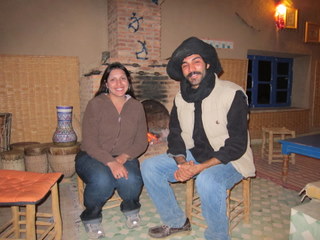The Desert: Marrakesh to Merzouga
Part I: Marrakesh to Skoura
The road through the Atlas Mountains should be called the road of a thousand curves. This 100 kilometer stretch to get across the Atlas is a difficult drive, but it is gorgeous. The road immediately outside Marrakesh is dominated by city traffic: scooters, donkeys pulling carts and lots of hitchhikers. Further on into the foothills, the views and curves start with lush, green oases of palm trees. Along with the windy road comes picturesque Kasbahs set into the mountains and locals selling geodes dyed bright red and green on the side of the road. After about half an hour, you think you are close to being done: but wait, there is more! The landscape turns to red, rocky cliffs, the curves become sharper and the incline steeper. How is this possible?! The only respite are the tiny towns along the way. The quality of the road is ok. It has two lanes the entire way, if a little narrow and is paved. I have to say, though, I am impressed by the skill of the local drivers. The local truck drivers drive fast, but are not reckless and try to give you space to let you pass in safe spots.
Just before Quarzazate, we turned off for a visit to Ait Benhaddou. The town really feels like it is frozen in time. While the Kasbah is not very populated, this Unesco World Heritage Site was worth the stop. After some negotiation, we had Ismael, a local Berber man, share the history of the Kasbah and provide some color commentary on the films that were shot there. Gladiator, Price of Persia, Jewel of the Nile, and many others were shot right in that spot, and many of the guides played extras in the movie for 50-100 dirham per day. We hear that a Bollywood movie is going to be shot there next!
This stop also helped explain why Atlas Studios is located on the outskirts of Quarzazate. We decided not to stop and tour the studious, and instead, pushed on to get to Skoura before sunset.
You’d never know there was more to Skoura than the small strip of town you pass through on the main road, unless you sleep there. Upon arrival in town, we couldn’t figure out where our hotel was, so we called them. To our surprise, instead of giving us directions, they told us to stay put and they would send someone to get us. This all made sense when one of the guys from the hotel after finding us in town, took us on a 20 minute bumpy trek on a dirt road for 7 miles, unveiling many homes and people in this little village. We stayed at Sawadi, which is located on a working organic farm, providing jobs to local people.
After a warm greeting from the dog, we dropped our bags in our cottage, and went over to the restaurant to have a home-cooked meal, with veggies directly from their garden. It was the perfect way to end our long day of driving.
Part II: Skoura to Merzouga
While it would have been great to spend the morning on a hammock by the pool, we left Sawadi early, as we wanted to make a few stops, and still arrive in Merzouga for sunset.
About 1.5 hours into the drive, we took a small detour to the Dades Gorge. It is a beautiful gorge, almost like a mini-grand canyon. I liked it enough, that it made me want to stop at the Todra as well. I am glad we did, as the two gorges are completely different. The view of the Dades is from the top, where you are at the bottom of the Todra, making it a great place for a day hike or some rock climbing.
While we made it to Merzouga for sunset, it was cloudy! I consoled myself with the panoramic view of the village of Merzouga and the dunes in the background. Our hotel, Kasbah Panorama, sits on top of a hill, so it was still a great place to have a “Berber Whiskey” (e.g. mint tea) and enjoy what we could see of the sunset.
It was a nice relaxing evening with Youssef and Ismael, the owners of the hotel. We had dinner, and then sat by the fire, and I chatted with Ismael until I couldn’t stay awake any longer.
Part III: The Desert
We spent the morning with Youssef, who took us to see the surrounding areas around Merzouga. We visited one of the shared ovens, where 15 or so Merzouga families cooked their bread every morning. Then, we stopped at the garden where each family has a plot for farming and explained how they share maintenance responsibilities of the irrigation pipelines in exchange for their precious water allocation. I think this is where the pea patch concept must have originated! We visited a nearby village, the old lead mines, Berber nomads in the black desert, and then had some “Berber pizza” with Youssef and his brother.
That afternoon, we trekked via camel into the Sahara dunes, where we would camp for the night. I could have done without sitting on a camel for a few hours, but watching the sunset on top of a dunes was worth it, and sliding down the dune was even better. We spent the night having dinner in the camp, chatting with a German couple who were also camping, and star gazing -I have never seen so many stars in the sky!









